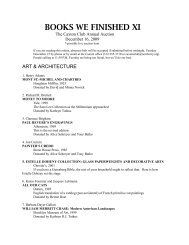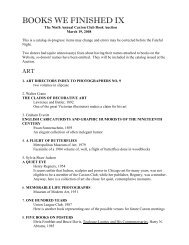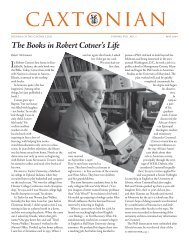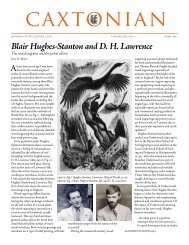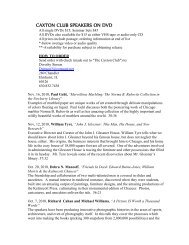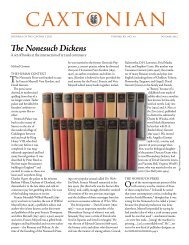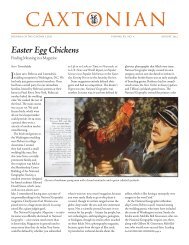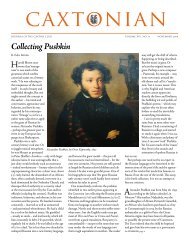Tales from an Iowa Flood - Caxton Club of Chicago
Tales from an Iowa Flood - Caxton Club of Chicago
Tales from an Iowa Flood - Caxton Club of Chicago
You also want an ePaper? Increase the reach of your titles
YUMPU automatically turns print PDFs into web optimized ePapers that Google loves.
caxtoni<strong>an</strong><br />
JOURNAL OF THE CAXTON CLUB VOLUME XVI, NO. 10 OCTOBER 2008<br />
<strong>Tales</strong> <strong>from</strong> <strong>an</strong> <strong>Iowa</strong> <strong>Flood</strong><br />
“Save the Victori<strong>an</strong> Periodicals!”<br />
Greg Prickm<strong>an</strong><br />
Students help to move collections on Friday<br />
The following is my recollection <strong>of</strong> the flooding<br />
that occurred in eastern <strong>Iowa</strong> this summer.<br />
At the University <strong>of</strong> <strong>Iowa</strong>, where I am Assist<strong>an</strong>t<br />
Head <strong>of</strong> Special Collections & University<br />
Archives, we faced a flood that was<br />
caused by water levels in a reservoir, rather<br />
th<strong>an</strong> a flash flood <strong>from</strong> <strong>an</strong> unregulated<br />
river. The result was a surreal mixture <strong>of</strong><br />
preparation <strong>an</strong>d apprehension. The event<br />
featured some <strong>of</strong> the worst scenarios we<br />
c<strong>an</strong> face as librari<strong>an</strong>s, but also <strong>an</strong> unexpected<br />
show <strong>of</strong> support for the library.<br />
Sunday, June 8<br />
I<br />
’m st<strong>an</strong>ding on top <strong>of</strong> the spillway<br />
at the Coralville Reservoir, a long<br />
stretch <strong>of</strong> rounded concrete that is now the<br />
only thing holding back the steadily rising<br />
waters flowing <strong>from</strong> the <strong>Iowa</strong> River into the<br />
Coralville Lake. All week long the Army<br />
Corps <strong>of</strong> Engineers has been increasing the<br />
outflow <strong>of</strong> the dam to hold the lake level<br />
below the spillway top where I’m currently<br />
bal<strong>an</strong>cing. Right now, the water is less th<strong>an</strong><br />
a foot <strong>from</strong> the top, lapping gently just<br />
inches below the curve <strong>of</strong> the concrete. My<br />
wife <strong>an</strong>d daughter <strong>an</strong>d I made the fifteen<br />
minute drive <strong>from</strong> <strong>Iowa</strong> City to see the<br />
Spillway <strong>from</strong> Coralville Lake, Sunday<br />
water bursting through<br />
the floodgates, literally, only to find<br />
that the spillway was easily accessible, with<br />
people gathering on top for a closer look at<br />
the rising waters. At this point the flood is<br />
certain <strong>an</strong>d inevitable, but the scene is eerily<br />
quiet <strong>an</strong>d odd. We could all be normal<br />
weekend sightseers. In the dist<strong>an</strong>ce lightning<br />
flashes <strong>from</strong> dark clouds – it rained<br />
again this morning, with more on the way.<br />
Tuesday, June 10<br />
The last major flood to<br />
affect the University <strong>of</strong><br />
<strong>Iowa</strong> was in 1993, part <strong>of</strong> the<br />
massive summer-long flooding<br />
that devastated large areas <strong>of</strong><br />
the Midwest. Now, with river<br />
levels rising again, 1993 has<br />
become the st<strong>an</strong>dard for how<br />
bad it c<strong>an</strong> be. We’re told that<br />
in 1993 a small amount <strong>of</strong><br />
water made its way in to the<br />
basement <strong>of</strong> the Main Library.<br />
Last week, the conventional<br />
wisdom was that although we would soon<br />
be facing a flood, it wouldn’t be as bad as<br />
1993. That seems to be ch<strong>an</strong>ging now, with<br />
more uncertainty about how high the river<br />
could rise. An email is sent to all staff in<br />
the Library asking us to check areas in the<br />
basement <strong>an</strong>d make sure things are <strong>of</strong>f the<br />
floor. In Special Collections & University<br />
Archives, given how much valuable material<br />
is stored in the basement, we know<br />
more needs to done th<strong>an</strong> to clear the floor.<br />
A meeting is set for tomorrow morning to<br />
begin pl<strong>an</strong>ning for all contingencies.<br />
Wednesday, June 11<br />
Staff <strong>from</strong> the Library Administration,<br />
Preservation, Facilities, <strong>an</strong>d Special<br />
Collections departments meet to discuss<br />
the situation. It is agreed that everything<br />
– m<strong>an</strong>uscript boxes, books, films, etc. – will<br />
See IOWA FLOOD, page 2
oC A X T O N I A N<br />
The <strong>Caxton</strong> <strong>Club</strong>, Founded 1895<br />
C. Steven Tomashefsky, President<br />
Adele Hast, Vice-President<br />
Sus<strong>an</strong> H<strong>an</strong>es, Secretary<br />
John C. Roberts, Treasurer<br />
Junie L. Sinson, Past President<br />
Council<br />
Class <strong>of</strong> 2009<br />
Rob Carlson<br />
Kim Coventry<br />
Ed Hirschl<strong>an</strong>d<br />
Wendy Husser<br />
David M<strong>an</strong>n<br />
Class <strong>of</strong> 2010<br />
Dorothy Anderson<br />
Don Chatham<br />
Mary Ann Johnson<br />
Philip R. Liebson<br />
J. William Locke<br />
Class <strong>of</strong> 2011<br />
Martha Chiplis<br />
Jill Gage<br />
Bradley Jonas<br />
D<strong>an</strong> “Skip” L<strong>an</strong>dt<br />
Alice D. Schreyer<br />
Appointed Officers<br />
Robert Karrow, Programs<br />
Paul F. Gehl, Archivist<br />
Hayward R. Blake, FABS<br />
Representative<br />
Fr<strong>an</strong>k J. Piehl, Histori<strong>an</strong><br />
Committees<br />
Thomas J. Joyce <strong>an</strong>d Dorothy L.<br />
Sinson, Audio Visual<br />
Robert Cotner, Development<br />
Kim Coventry, Exhibitions<br />
Adele Hast, Fin<strong>an</strong>ce<br />
Ed Quattrocchi (Honorary Chair),<br />
J. William Locke, Dorothy Sinson<br />
(Co-Chairs), Friday Luncheons<br />
D<strong>an</strong> “Skip” L<strong>an</strong>dt, Membership<br />
Junie L. Sinson, Nobel Study<br />
Sus<strong>an</strong> Rossen, Publications<br />
Edward C. Bronson, Web Site<br />
<strong>Caxton</strong> <strong>Club</strong> Staff<br />
D<strong>an</strong> Crawford, General M<strong>an</strong>ager<br />
<strong>Caxton</strong>i<strong>an</strong><br />
Robert McCam<strong>an</strong>t, Editor<br />
Wendy Husser, Copy Editor<br />
Robert Cotner, Founder<br />
Kathryn DeGraff, Matthew<br />
J.Doherty, Wendy Husser, Paul<br />
Ruxin, Florence Shay, Contributing<br />
Editors<br />
©2008, The <strong>Caxton</strong> <strong>Club</strong>. The <strong>Caxton</strong>i<strong>an</strong> is<br />
published monthly by The <strong>Caxton</strong> <strong>Club</strong>, whose<br />
<strong>of</strong>fice is in the Newberry Library. Printing: River<br />
Street Press, Aurora, IL.<br />
IOWA FLOOD, <strong>from</strong> page 1<br />
be removed <strong>from</strong> the bottom shelves in the<br />
basement. The main threat continues to be the<br />
possibility <strong>of</strong> water seeping in through drains<br />
<strong>an</strong>d <strong>from</strong> the loading dock, so it will threaten<br />
the lowest material first. We will begin the move<br />
immediately <strong>an</strong>d use student help, relocating<br />
materials to a fifth-floor lounge that c<strong>an</strong> be<br />
secured. The next few hours are spent coordinating<br />
the details – we somehow have to label the<br />
boxes we remove with their specific shelf locations,<br />
or we will have great difficulty ever putting<br />
them back in the correct order. Labels are printed,<br />
markers <strong>an</strong>d tape gathered, staff assembled. A<br />
further complication is the compact shelving<br />
in the basement. We c<strong>an</strong> only have one aisle<br />
open in each <strong>of</strong> four sections <strong>of</strong> shelving, which<br />
makes the flow <strong>of</strong> materials tricky. There is only<br />
one door out <strong>of</strong> our storage area, up a ramp <strong>an</strong>d<br />
through a narrow twisting hallway. These factors<br />
are eventually accounted for <strong>an</strong>d by early afternoon,<br />
book trucks full <strong>of</strong> boxes are beginning to<br />
make their way out <strong>of</strong> the basement <strong>an</strong>d up to<br />
the fifth floor.<br />
<strong>an</strong> indicator, <strong>an</strong>d there is concern that we may<br />
in fact face river water on the first floor <strong>of</strong> the<br />
Library – well above our collections in the basement.<br />
Rumors are swirling, that the bridges over<br />
the river will be closed, the highways shut down,<br />
buildings closed, the town essentially cut <strong>of</strong>f <strong>from</strong><br />
the outside world as the river reaches 500-year<br />
flood levels. It is decided late in the day that we<br />
will continue to remove as m<strong>an</strong>y collections as<br />
we possibly c<strong>an</strong> <strong>from</strong> the basement <strong>an</strong>d work<br />
through the weekend if we have to. Overnight,<br />
<strong>an</strong>other severe storm crashes through <strong>Iowa</strong> City,<br />
dumping extraordinary amounts <strong>of</strong> rain on oversaturated<br />
soil. Lightning explodes right outside<br />
my house, knocking out the power. In the darkness,<br />
my wife <strong>an</strong>d I listen to reports on the radio<br />
as levees begin giving way <strong>an</strong>d neighborhoods fill<br />
rapidly with water.<br />
Friday, June 13 – Morning<br />
The word goes out to all Library staff first<br />
thing in the morning – help is needed in the<br />
basement. Volunteers to move boxes are arr<strong>an</strong>ged<br />
in two hour shifts, <strong>an</strong>d work quickly gets under<br />
Thursday, June 12<br />
Students form a hum<strong>an</strong> chain to move books safely <strong>an</strong>d efficiently.<br />
Relocating materials continues<br />
first thing in the<br />
morning, <strong>an</strong>d the effort is<br />
completed by early afternoon.<br />
Tension is rising along with<br />
the river, <strong>an</strong>d the reports <strong>from</strong><br />
Cedar Rapids to the north<br />
are beyond all predictions as<br />
conditions deteriorate rapidly.<br />
The normally well-ordered<br />
world <strong>of</strong> Special Collections<br />
& University Archives has<br />
been upended, with our collections<br />
stored in a lounge<br />
held safe by just a padlocked<br />
door. Preservation has taken<br />
on a new dimension <strong>of</strong> relative<br />
scale – the stability <strong>of</strong> our<br />
material is compromised to<br />
some degree as soon as it’s<br />
relocated, but at least it is no<br />
longer directly threatened by<br />
the looming water. Toward<br />
late afternoon, however,<br />
there is a growing sense that<br />
we need to go further <strong>an</strong>d<br />
remove more material, as the<br />
predictions <strong>of</strong> the river’s crest<br />
continue to rise. The year<br />
1993 is no longer relev<strong>an</strong>t as<br />
The <strong>Caxton</strong> <strong>Club</strong> • 60 W Walton St, <strong>Chicago</strong>, IL 60610 3305 • ph 312 255 3710 • caxtonclub@newberry.org • www.caxtonclub.org
way. Soon the situation worsens. Rather<br />
th<strong>an</strong> having the weekend, as had been<br />
assumed, we are informed that we must<br />
leave the building at 5:00 pm, <strong>an</strong>d it will<br />
be locked behind us with no one allowed<br />
re-entry. The river is rising quickly <strong>an</strong>d<br />
unpredictably, <strong>an</strong>d safety has become <strong>an</strong><br />
issue with bridge closings looming. Our<br />
fifth floor lounge is also nearly full, <strong>an</strong>d we<br />
begin directing volunteers to the third floor<br />
hallway outside the Special Collections<br />
& University Archives department where<br />
archival boxes rapidly form long stacks.<br />
books <strong>from</strong> one person to the next <strong>from</strong><br />
<strong>an</strong>other non-Special Collections storage<br />
location, snaking <strong>from</strong> the far corners <strong>of</strong><br />
the basement up two stories <strong>of</strong> stairs to the<br />
second floor. I’m asked if Special Collections<br />
c<strong>an</strong> use <strong>an</strong>y <strong>of</strong> these additional volunteers,<br />
<strong>an</strong>d we quickly form a hum<strong>an</strong> chain<br />
passing dissertations out <strong>of</strong> our storage<br />
area while book trucks full <strong>of</strong> heavy m<strong>an</strong>uscript<br />
boxes continue to flow through the<br />
same single door out <strong>of</strong> the room. There is<br />
<strong>an</strong> air <strong>of</strong> excitement <strong>an</strong>d nervous adrenaline,<br />
a sense <strong>of</strong> camaraderie among those<br />
Despite working for much <strong>of</strong> the day,<br />
when <strong>an</strong> <strong>an</strong>nouncement is made<br />
that our deadline for leaving the building<br />
is extended to 9:00 pm, m<strong>an</strong>y volunteers<br />
cheer. I’m told later that someone shouted<br />
“save the Victori<strong>an</strong> periodicals!” when<br />
that section was reached. In the midst <strong>of</strong><br />
keeping everything going, I’m vaguely aware<br />
<strong>of</strong> the m<strong>an</strong>y layers <strong>of</strong> exhilaration, fear, <strong>an</strong>d<br />
bewilderment I’m experiencing: all <strong>of</strong> these<br />
people let loose in our stacks...but here to<br />
help us. Thous<strong>an</strong>ds <strong>of</strong> boxes stacked in a<br />
hallway...but safe <strong>from</strong> the water. And I’m<br />
hoping no one confronts me with the question<br />
that’s burning in the back <strong>of</strong> my mind:<br />
why is all <strong>of</strong> this sitting in the basement<br />
<strong>an</strong>yway Isn’t it too import<strong>an</strong>t for that I<br />
don’t w<strong>an</strong>t to get into the complications<br />
<strong>of</strong> temporary storage, the pl<strong>an</strong>ned <strong>of</strong>f-site<br />
facility, <strong>an</strong>d the compromises all libraries<br />
face. We just move the boxes, doing all we<br />
c<strong>an</strong> to protect as much as we c<strong>an</strong>. By 7:00<br />
pm we have cleared three shelves high,<br />
nearly five feet <strong>from</strong> the floor, <strong>from</strong> the<br />
entire basement storage room. That me<strong>an</strong>s<br />
we have relocated more th<strong>an</strong> 14,000 linear<br />
feet in the course <strong>of</strong> two <strong>an</strong>d a half days.<br />
The Governor has brought food for the<br />
volunteers upstairs, but Sid <strong>an</strong>d I st<strong>an</strong>d in<br />
the third floor hallway, taking in the sight<br />
<strong>of</strong> our collections filling the space, knowing<br />
that when we make it through this, we have<br />
to put it all back. And I leave the building,<br />
not to return for weeks, afraid that we<br />
haven’t done enough.<br />
Sid Huttner, head <strong>of</strong> the department, is<br />
at one end <strong>of</strong> the basement coordinating<br />
the elevator <strong>an</strong>d carts. I’m in our storage<br />
room, directing volunteers as they remove<br />
collections. I begin to notice that m<strong>an</strong>y <strong>of</strong><br />
the people arriving to help are unfamiliar to<br />
me. More <strong>an</strong>d more people arrive, <strong>an</strong>d now<br />
I do recognize some <strong>of</strong> them – staff <strong>from</strong><br />
the public library, faculty members <strong>from</strong><br />
English, History, Film Studies, graduate<br />
students.<br />
Friday, June 13 – Afternoon<br />
More time passes: a blur <strong>of</strong> book trucks,<br />
the three-dimensional puzzle <strong>of</strong><br />
compact shelving, <strong>an</strong>d the tight confines<br />
we’re navigating. A call for volunteers at<br />
the library has gone out through the local<br />
media, <strong>an</strong>d hundreds <strong>of</strong> people, w<strong>an</strong>ting to<br />
help “save the library,” as they put it, are here<br />
to help. Hum<strong>an</strong> chains are formed to pass<br />
volunteering. Faculty members point out<br />
material they didn’t know we had, <strong>an</strong>d we<br />
engage in a bizarre form <strong>of</strong> outreach, all the<br />
while hoping everything arrives at its new<br />
location intact.<br />
Friday, June 13 – Evening<br />
Saturday, June 14<br />
After weeks <strong>of</strong> storms, the next day<br />
dawns with beautiful sunshine. My<br />
wife <strong>an</strong>d I push our daughter in her stroller<br />
down to the river. The Burlington Street<br />
bridge is still open, <strong>an</strong>d we walk out on it.<br />
The water rushes against the bottom <strong>an</strong>d is<br />
still rising, <strong>an</strong>d a large team <strong>of</strong> volunteers<br />
continues to fill s<strong>an</strong>dbags energetically<br />
across <strong>from</strong> the library. They are <strong>an</strong> isl<strong>an</strong>d<br />
<strong>of</strong> activity surrounded by quiet – all University<br />
personnel have been gr<strong>an</strong>ted a week<br />
<strong>of</strong> leave <strong>an</strong>d told to stay away <strong>from</strong> campus.<br />
It’s a summer vacation in the midst <strong>of</strong> a<br />
natural disaster, one still unfolding as we<br />
head for home to stay out <strong>of</strong> the way, to<br />
wait for the river to crest.<br />
Aftermath<br />
The river crests two days earlier th<strong>an</strong><br />
predicted, <strong>an</strong>d lower th<strong>an</strong> feared. The<br />
library does take on water in the basement,<br />
but in the collection storage rooms it only<br />
reaches between 3 to 6 inches deep, <strong>an</strong>d<br />
doesn’t affect <strong>an</strong>y materials. This still results<br />
in a lengthy disaster recovery process<br />
involving outside contractors which keeps<br />
us out <strong>of</strong> the building for <strong>an</strong>other month.<br />
Our effort is a success, protecting materials<br />
<strong>from</strong> the water <strong>an</strong>d the potential damage <strong>of</strong><br />
the recovery. This is small comfort to other<br />
areas on campus, such as the art, music, <strong>an</strong>d<br />
theater buildings where the water reached<br />
See IOWA FLOOD, page 4<br />
CAXTONIAN, OCTOBER 2008
IOWA FLOOD, <strong>from</strong> page 3<br />
more th<strong>an</strong> five feet in depth <strong>an</strong>d devastated<br />
the facilities, or to institutions like the<br />
Czech & Slovak Museum & Library <strong>an</strong>d<br />
the Afric<strong>an</strong> Americ<strong>an</strong> Museum, both in<br />
Cedar Rapids <strong>an</strong>d victims <strong>of</strong> severe flood<br />
damage.<br />
As I write this, at the beginning <strong>of</strong><br />
August, we are fully moved back into the<br />
Main Library, <strong>an</strong>d the only materials left<br />
to move back to the basement are some <strong>of</strong><br />
the book collections still stored in the fifth<br />
floor lounge. Our hallway is cleared, the<br />
reading room is functional, <strong>an</strong>d day-to-day<br />
operations appear to be normal – it’s even<br />
easy to take for gr<strong>an</strong>ted the large yellow<br />
tube blowing reconditioned warm air up a<br />
staircase <strong>an</strong>d into a back hallway. Until <strong>of</strong>fsite<br />
storage relieves the burden <strong>of</strong> crowding<br />
in the rest <strong>of</strong> the Library, it will be difficult<br />
to rest easy, but at least we now know the<br />
lengths to which people will go to protect<br />
the Library, <strong>an</strong>d the import<strong>an</strong>ce <strong>of</strong> these<br />
books <strong>an</strong>d papers to the community they<br />
support.<br />
§§<br />
Photographs by the author.<br />
<strong>Caxton</strong> <strong>Club</strong> Donor<br />
Roll <strong>of</strong> Honor,<br />
2007-2008 Fiscal Year<br />
The <strong>Club</strong> th<strong>an</strong>ks its m<strong>an</strong>y donors,<br />
without whose generosity we could not<br />
have accomplished all we did during<br />
our past fiscal year, which ended June<br />
30. Though we operate very efficiently,<br />
dues <strong>an</strong>d meeting charges do not fully<br />
cover the cost <strong>of</strong> providing the programs<br />
<strong>an</strong>d publications we all enjoy, such as<br />
speaker honoraria, the <strong>Caxton</strong>i<strong>an</strong>, the<br />
Symposium on the Book, our scholarship<br />
program for students in the book<br />
arts, <strong>an</strong>d our publications. The following<br />
donors have made it possible for us<br />
to be a better <strong>Club</strong>, <strong>an</strong>d we are most<br />
grateful for their support. If you are<br />
interested in joining their number by<br />
making a contribution, please let me<br />
know or follow the “Gift Opportunities”<br />
link on our web site.<br />
– Steve Tomashefsky<br />
Unrestricted Gifts<br />
Adri<strong>an</strong> Alex<strong>an</strong>der<br />
Anonymous<br />
Patricia N. Barnes<br />
Roger S. Baskes<br />
Anthony J. Batko & Alice D. Schreyer<br />
Greta Bever<br />
Kimberly Boyer<br />
William Brace<br />
Thomas H. Brown<br />
Philip M. Burno<br />
Don Chatham<br />
William L.M.H. Clark<br />
Peder Dahlberg<br />
James R. Donnelley<br />
William Drendel<br />
Bri<strong>an</strong> B. Duff<br />
George E. Engdahl<br />
Michael Ev<strong>an</strong><strong>of</strong>f<br />
Thomas Fitzpatrick<br />
Paul F. Gehl<br />
Charles C. Haffner III<br />
Sus<strong>an</strong> R. H<strong>an</strong>es<br />
Lee J. Harrer<br />
David P. Hartm<strong>an</strong>n<br />
Donald A. Henegh<strong>an</strong><br />
Eugene Hotchkiss III<br />
Michael S. Huckm<strong>an</strong><br />
Norm<strong>an</strong> Jung<br />
Robert Q. Kelly<br />
George E. Leonard III &<br />
Sus<strong>an</strong> R. H<strong>an</strong>es<br />
Sus<strong>an</strong> M. Levy<br />
Joseph Like<br />
Barbara Denemark Long<br />
David S. M<strong>an</strong>n<br />
Robert E. McCam<strong>an</strong>t<br />
Trum<strong>an</strong> T. Metzel, Jr. &<br />
Dorothy J. Anderson<br />
Jerry Meyer<br />
Charles L. Miner<br />
Ernest Mond<br />
Edward A. Quattrocchi<br />
(in memory <strong>of</strong> Carolyn)<br />
John C. Roberts<br />
Norma B. Rubovits<br />
Ione Strum<br />
Peggy Sulliv<strong>an</strong><br />
Thomas E. Sw<strong>an</strong>strom<br />
Marilyn Sward<br />
Michael Thompson<br />
Steve Tomashefsky<br />
James S. Tomes<br />
Josie Tomes<br />
Muriel Underwood<br />
James S. Wells<br />
R. Quincy White<br />
Symposium on the Book<br />
Michele Miller Burns<br />
The Gladys Krieble Delmas Foundation<br />
Paul F. Gehl<br />
Adele Hast<br />
Wendy Cowles Husser<br />
The Illinois Hum<strong>an</strong>ities Council<br />
Anthony J. Mourek<br />
Steve Tomashefsky<br />
Jack Weiner<br />
Second Century Fund<br />
Adri<strong>an</strong> Alex<strong>an</strong>der<br />
Bruce H. Boyer<br />
John P. Chalmers<br />
James R. Donnelley<br />
Samuel Ellenport<br />
Paul F. Gehl<br />
Charles C. Haffner III<br />
Paul T. Ruxin<br />
Special Projects Fund<br />
John C. Blew<br />
Kim Coventry<br />
William Drendel<br />
Celia Hilliard<br />
David C. Meyer<br />
Ron Offen<br />
Caryl Seidenberg<br />
<strong>Caxton</strong>i<strong>an</strong><br />
T. Kimball Brooker<br />
D<strong>an</strong> Crawford<br />
R. Eden Martin<br />
Scholarship Fund<br />
Adri<strong>an</strong> Alex<strong>an</strong>der<br />
Phillip R. Liebson<br />
Linda Naru<br />
Junie Sinson<br />
Building Fund<br />
Junie Sinson<br />
CAXTONIAN, OCTOBER 2008
C A X T O N I A N<br />
Wynken de Worde<br />
Cormac McCarthy is <strong>an</strong> elusive, reclusive<br />
writer’s writer who m<strong>an</strong>aged<br />
to avoid popular notice through his first<br />
h<strong>an</strong>dful <strong>of</strong> works, breaking into popular<br />
awareness with his 1993 novel, All The<br />
Pretty Horses.<br />
Horses is the first volume in McCarthy’s<br />
Border Trilogy, <strong>an</strong>d won the 1993 National<br />
Book Award. I know <strong>of</strong> one local rare<br />
bookseller who had two copies <strong>of</strong> McCarthy’s<br />
first book, a novel called The Orchard<br />
Keeper. He had two copies <strong>of</strong> the first printing,<br />
which was only 3000 copies, <strong>an</strong>d most<br />
<strong>of</strong> them had been sold to libraries. He had<br />
held on to them because <strong>of</strong> the uncommonly<br />
high quality <strong>of</strong> the reviews – the<br />
blurbs – on the dust jacket.<br />
When the McCarthy surge beg<strong>an</strong>, he<br />
agreeably sold the lesser copy for his list<br />
price <strong>of</strong> ten dollars. That was to benefit the<br />
lucky collector who found it first. Wishing<br />
to be not utterly foolish, he doubled the list<br />
price on the nicer copy <strong>an</strong>d priced it a full<br />
twenty-five dollars! Today the lowliest exlibrary<br />
copy <strong>of</strong> it is listing for two hundred<br />
<strong>an</strong>d fifty dollars, while a price-clipped copy<br />
is being hawked at thirty-five hundred<br />
dollars.<br />
A still-later novel, No Country For Old<br />
Men, was turned into a remarkable, Oscarwinning<br />
film. If you have seen the film,<br />
<strong>an</strong>d were intrigued by it, you ought to read<br />
the book. The first reason is because it<br />
will clarify who the main character is. The<br />
second reason is that, despite that about<br />
ninety-five percent <strong>of</strong> the book gets into<br />
the film, there are some episodes critical to<br />
underst<strong>an</strong>ding the main character which do<br />
not fully appear in the movie.<br />
McCarthy followed up with <strong>an</strong>other<br />
novel which is being filmed. It won Oprah’s<br />
endorsement <strong>an</strong>d the Pulitzer Prize for<br />
Fiction. It is The Road. It is a dark book<br />
which is entirely episodic. It is largely<br />
related in short scenes, some <strong>of</strong> which are<br />
only a few sentences, a few <strong>of</strong> which run on<br />
for three pages. It will be quite a challenge<br />
for the screenwriter.<br />
McCarthy’s fellow Tex<strong>an</strong>-in-film is Larry<br />
McMurtry. If you combine All The Pretty<br />
Horses <strong>an</strong>d The Road, you approximate<br />
McMurtry’s first book, Horsem<strong>an</strong>, Pass By.<br />
That was turned by Hollywood into The<br />
Last Picture Show.<br />
F O O T N O T E S<br />
In his recent autobiography, Books: A<br />
Memoir, McMurtry relates how his early<br />
love <strong>of</strong> reading in a nearly book-less household<br />
led him to compose his novel about<br />
his hometown, Archer City, Texas. McMurtry’s<br />
memoir is episodic, providing snatches<br />
<strong>of</strong> narrative, which makes it harder to read<br />
(as is The Road) <strong>an</strong>d, thus, harder to enjoy,<br />
which is a shame for confirmed bibliophiles<br />
who may already have savored the delights<br />
<strong>of</strong> Helene H<strong>an</strong>ff ’s 84 Charing Cross Road,<br />
or Percy Muir’s Minding My Own Business,<br />
or Charlie Everitt’s Adventures <strong>of</strong> a Treasure<br />
Hunter, <strong>an</strong>d Memoirs <strong>of</strong> a Book Snake<br />
– both produced by David Meyer (’81).<br />
McMurtry’s books lack the narrative flow<br />
<strong>of</strong> these others, but they do contain m<strong>an</strong>y<br />
rewarding nuggets for <strong>an</strong>yone interested<br />
in the state <strong>of</strong> new <strong>an</strong>d used bookselling at<br />
the close <strong>of</strong> the second millenium <strong>an</strong>d the<br />
inf<strong>an</strong>cy <strong>of</strong> the third. McMurtry explains<br />
why he would rather sell books th<strong>an</strong> write<br />
them. He describes his motivation for creating<br />
his own book town in Archer City, as<br />
a destination for bibliophiles as well as why<br />
he will now be closing it down.<br />
§§<br />
Additional News <strong>from</strong> Cedar Rapids, <strong>Iowa</strong><br />
The Afric<strong>an</strong> Americ<strong>an</strong> Museum<br />
<strong>of</strong> Cedar Rapids was in the area <strong>of</strong><br />
downtown which experienced the worst<br />
flooding. But all was not lost; they report<br />
on their web site that “90-95% <strong>of</strong> the collection<br />
has been or c<strong>an</strong> be saved.” Artifacts<br />
have been sorted <strong>an</strong>d dealt with appropriately.<br />
They hope to return to their building<br />
by Th<strong>an</strong>ksgiving, <strong>an</strong>d be open to the public<br />
around J<strong>an</strong>uary 1.<br />
Sus<strong>an</strong> Kuecker, the curator, said that<br />
the library did not fare so well as the other<br />
parts <strong>of</strong> the collection. Fortunately, the<br />
few valuable books they had – association<br />
copies <strong>an</strong>d limited editions – were stored<br />
in a high part <strong>of</strong> the collection room, <strong>an</strong>d<br />
were thus safe. But the reference library was<br />
entirely destroyed.<br />
They had just completed (ironically, on<br />
June 3!) cataloging the reference library,<br />
so they have a complete record <strong>of</strong> what<br />
they lost, some 1100 volumes <strong>of</strong> Afric<strong>an</strong><br />
Americ<strong>an</strong> history <strong>from</strong> the last fifty years.<br />
“Actually, our <strong>Iowa</strong>-specific materials seem<br />
to be easier to replace th<strong>an</strong> the general US<br />
material,” Kuecker explained. “Local people<br />
are more aware <strong>of</strong> us, so the <strong>Iowa</strong> material<br />
is already starting to trickle in.” So Kuecker<br />
would be most grateful for the donation<br />
<strong>of</strong> books <strong>from</strong> people’s collections. She<br />
mentioned Dubois, Taylor Br<strong>an</strong>ch, <strong>an</strong>d Dr.<br />
King as being typical subjects <strong>an</strong>d authors<br />
that would be welcomed. The best way to<br />
contact her is via e-mail, to:<br />
curator@blackiowa.org<br />
National Czech <strong>an</strong>d Slovak<br />
Museum & Library president<br />
Gail Naughton said flood damage at the<br />
museum’s five properties in Czech Village<br />
<strong>of</strong> Cedar Rapids is approaching $9 million.<br />
However, a r<strong>an</strong>ge <strong>of</strong> <strong>of</strong>ficial <strong>an</strong>d private<br />
sources have stepped up with aid. The<br />
Czech government has allocated $630,000<br />
to use for flood relief for several Cedar<br />
Rapids institutions. In July, U.S. Senator<br />
Tom Harkin (D-IA) <strong>an</strong>nounced that the<br />
Institute <strong>of</strong> Museum <strong>an</strong>d Library Services<br />
had awarded $116,699 to the museum.<br />
Currently, all five buildings have been<br />
cle<strong>an</strong>ed <strong>an</strong>d secured. However, they are<br />
not rushing to re-occupy them, but instead<br />
trying to pl<strong>an</strong> how they c<strong>an</strong> use the tragedy<br />
as <strong>an</strong> opportunity to re-think <strong>an</strong>d focus the<br />
efforts <strong>of</strong> the museum. The pl<strong>an</strong> is for <strong>an</strong><br />
interim, temporary location to open as soon<br />
as possible, permitting time for thoughtful<br />
future pl<strong>an</strong>ning.<br />
The museum has decided to do <strong>an</strong> oral<br />
history <strong>of</strong> the flood, called “My <strong>Flood</strong><br />
Story.” It’s being done in conjuntion with<br />
<strong>an</strong> <strong>Iowa</strong> group called Tallgrass Histori<strong>an</strong>s.<br />
They’re also collecting written <strong>an</strong>d photographed<br />
items at myfloodstory@ncsml.org.<br />
§§<br />
CAXTONIAN, OCTOBER 2008
Book <strong>an</strong>d m<strong>an</strong>uscript-related<br />
exhibitions: a selective list<br />
Compiled by Bernice E. Gallagher<br />
(Note: on occasion <strong>an</strong> exhibit may be delayed or<br />
extended; it is always wise to call in adv<strong>an</strong>ce <strong>of</strong> a visit)<br />
Two exhibitions are being presented at the Art Institute <strong>of</strong> <strong>Chicago</strong>, 111<br />
S. Michig<strong>an</strong> Ave., <strong>Chicago</strong> 312-443-3600: “D<strong>an</strong>iel Burnham’s Pl<strong>an</strong><br />
<strong>of</strong> <strong>Chicago</strong>” (a preview <strong>of</strong> the citywide celebration <strong>of</strong> the Burnham<br />
Pl<strong>an</strong> Centennial that begins in J<strong>an</strong>uary, including maps, diagrams,<br />
perspective drawings <strong>an</strong>d watercolors, historically signific<strong>an</strong>t <strong>an</strong>d<br />
artistically exceptional, m<strong>an</strong>y <strong>of</strong> them in fragile condition <strong>an</strong>d<br />
rarely displayed publicly) in Gallery 24 (through December 15);<br />
“The Bill Peet Storybook Menagerie” (sketches, storyboards <strong>an</strong>d<br />
thirty-four books by Bill Peet, creator <strong>of</strong><br />
Dumbo <strong>an</strong>d Cinderella <strong>an</strong>d Walt Disney’s<br />
principle <strong>an</strong>imator for twenty-seven years) in<br />
Galleries 15 <strong>an</strong>d 16 (through May 24, 2009).<br />
Two related exhibitions will open at the <strong>Chicago</strong><br />
Architecture Foundation, 224 S. Michig<strong>an</strong><br />
Ave., <strong>Chicago</strong> 312-922-3432: “Sh<strong>an</strong>ghai<br />
Tr<strong>an</strong>sforming” (graphics, photographs <strong>an</strong>d<br />
maps exploring the city’s rapid ch<strong>an</strong>ge, recognizing<br />
its past <strong>an</strong>d speculating about future<br />
possibilities) in the John Buck Comp<strong>an</strong>y<br />
Lecture Hall Gallery (October 14-J<strong>an</strong>uary<br />
9, 2009); “Boom Towns! <strong>Chicago</strong> Architects<br />
Design New Worlds” (photographs, drawings,<br />
graphics, models <strong>an</strong>d videos pairing<br />
iconic architecture <strong>from</strong> late 19th century<br />
<strong>Chicago</strong> with parallel works in today’s China<br />
<strong>an</strong>d the Middle East) in the Atrium Gallery<br />
(through November 21).<br />
“Mushrooms <strong>an</strong>d More” (beautifully illustrated<br />
color plates <strong>from</strong> the Rare Book Collection,<br />
featuring the amazing r<strong>an</strong>ge <strong>of</strong> mushroom<br />
species) in the Lenhardt Library, <strong>Chicago</strong><br />
Bot<strong>an</strong>ic Garden, 1000 Lake Cook Road, Glencoe 847-835-8202<br />
(through November 23).<br />
“Catholic <strong>Chicago</strong>” (books, historic documents, maps, architectural<br />
drawing, artifacts <strong>an</strong>d film footage, exploring ways that religious<br />
communities shaped the ever-ch<strong>an</strong>ging urb<strong>an</strong> l<strong>an</strong>dscape) at the<br />
<strong>Chicago</strong> History Museum, 1501 N. Clark Street, <strong>Chicago</strong> 312-642-<br />
4600 (through J<strong>an</strong>uary 4, 2009).<br />
“On the Road with Jack Kerouac + Experimental Literature <strong>an</strong>d<br />
the Intersection with Artists’ Books” (features Kerouac’s original<br />
m<strong>an</strong>uscript – 120 feet long <strong>an</strong>d nine inches wide, fed through his<br />
typewriter without interruption – as the centerpiece <strong>of</strong> <strong>an</strong> exhibition<br />
<strong>of</strong> artists’ books in experimental literature) at Columbia<br />
College Center for Book <strong>an</strong>d Paper Arts, 1104 S. Wabash, <strong>Chicago</strong><br />
312-344-6630 (October 4-November 26).<br />
“Priests for Peace: The Nonviolent Roots <strong>of</strong> 1968 Protests” (items<br />
<strong>from</strong> the collection <strong>of</strong> D<strong>an</strong>iel Berrig<strong>an</strong> – Jesuit priest, social activist,<br />
author <strong>of</strong> nonfiction <strong>an</strong>d poetry – featuring works <strong>an</strong>notated<br />
by Berrig<strong>an</strong> while in prison as well as copies <strong>of</strong> works by Buddhist<br />
monk Thich Nhat Hahn) in Special Collections <strong>an</strong>d Archives,<br />
Room 314, John T. Richardson Library, DePaul University, 2350 N.<br />
Kenmore Avenue, <strong>Chicago</strong> 773-325-2167 (through November 1).<br />
CAXTONIAN, OCTOBER 2008<br />
“1968: Art <strong>an</strong>d Politics in <strong>Chicago</strong>” (diverse artistic responses to the 1968<br />
Democratic National Convention, including posters, photographs <strong>an</strong>d<br />
documents as well as sculpture <strong>an</strong>d paintings) in the Main Gallery,<br />
DePaul University Museum, 2350 N. Kenmore Avenue, <strong>Chicago</strong> 773-<br />
325-7506 (through November 23).<br />
Two ongoing exhibitions are featured at the DuSable Museum <strong>of</strong> Afric<strong>an</strong><br />
Americ<strong>an</strong> History, 740 East 56th Place, <strong>Chicago</strong> 773-947-0600: “Forgotten<br />
Roots: Muslims in Early America Through the 20th Century”<br />
(historical documents <strong>an</strong>d photographs highlighting America’s rich<br />
Islamic heritage, <strong>from</strong> the 17th century to the present); “Wisdom <strong>of</strong><br />
Words: Lerone Bennett Jr., The People’s Histori<strong>an</strong>” (includes copies<br />
<strong>of</strong> Bennett’s ten books documenting the historical forces shaping the<br />
Black experience in the United States, plus rarely seen vintage copies<br />
<strong>of</strong> JET <strong>an</strong>d Ebony magazines).<br />
“The Art <strong>of</strong> Democracy” (timed to coincide with the 2008 Presidential<br />
election, featuring work by sixty printmakers<br />
whose posters <strong>an</strong>d print media are concerned<br />
with democracy, social activism <strong>an</strong>d<br />
political ch<strong>an</strong>ge) in the Loyola University<br />
Museum <strong>of</strong> Art, 820 N. Michig<strong>an</strong> Ave.,<br />
<strong>Chicago</strong> 312-915-7600 (through Nov. 9).<br />
“Artifacts <strong>of</strong> Childhood: 700 Years <strong>of</strong> Children’s<br />
Books (works by <strong>an</strong>d for children<br />
in more th<strong>an</strong> 100 l<strong>an</strong>guages <strong>from</strong> the<br />
fifteenth century to the present, including<br />
the first edition <strong>of</strong> Lewis Carroll’s Alice’s<br />
Adventures in Wonderl<strong>an</strong>d [1865] <strong>an</strong>d<br />
ABCs <strong>from</strong> 1544 to 1992) at the Newberry<br />
Library, 60 W. Walton Street, <strong>Chicago</strong> 312-<br />
943-9090 (through J<strong>an</strong>uary 17, 2009).<br />
Two exhibitions are on display in the Special<br />
Collections Research Center, Joseph<br />
Regenstein Library, University <strong>of</strong> <strong>Chicago</strong>,<br />
1100 East 57th Street, <strong>Chicago</strong> 773-702-<br />
8705: “Integrating the Life <strong>of</strong> the Mind:<br />
Afric<strong>an</strong> Americ<strong>an</strong>s at the University <strong>of</strong><br />
<strong>Chicago</strong>” (archival documents <strong>an</strong>d published<br />
materials highlighting the history<br />
<strong>of</strong> Afric<strong>an</strong> Americ<strong>an</strong>s at the University, beginning in the nineteenth<br />
century <strong>an</strong>d exploring individual paths <strong>of</strong> adoption/adaptation, activism/despair,<br />
institutionalization/radicalization) in the Main Gallery<br />
(through February 27, 2009); “East Europe<strong>an</strong> Jews in the Germ<strong>an</strong>-<br />
Jewish Imagination” (documents tracing the complex <strong>an</strong>d contradictory<br />
influence <strong>of</strong> this group up to the eve <strong>of</strong> World War II) in the<br />
Gallery <strong>of</strong> the Ludwig Rosenberger Library (through June 22, 2009).<br />
“Chester Commodore, 1914-2004: The Work <strong>an</strong>d Life <strong>of</strong> a Pioneering<br />
Cartoonist <strong>of</strong> Color” (original cartoons, photographs, letters, awards<br />
<strong>an</strong>d other memorabilia relating to the artist’s work as editorial cartoonist<br />
for the <strong>Chicago</strong> Defender; with additional material <strong>from</strong> the<br />
<strong>Chicago</strong> Public Library’s Vivi<strong>an</strong> Harsh Research Collection) at the<br />
Carter G. Woodson Regional Library, 9525 S. Halsted Street, <strong>Chicago</strong><br />
312-745-2080 (through December 31).<br />
“State Street: That Great Street” (clippings, books <strong>an</strong>d memorabilia<br />
exploring the history <strong>an</strong>d attractions <strong>of</strong> State Street over 150 years) in<br />
the <strong>Chicago</strong> Gallery, 3rd Floor, Harold Washington Library Center,<br />
400 S. State Street, <strong>Chicago</strong> 312-747-4300 (through June 21, 2009).<br />
Catholic <strong>Chicago</strong> at <strong>Chicago</strong> History Museum<br />
scenes <strong>from</strong> “Growing up Catholic”<br />
Bernice Gallagher will be happy to receive your listings at either<br />
847-234-5255 or gallagher@lakeforest.edu.
<strong>Caxton</strong>i<strong>an</strong>s Collect: Gerald Baum<strong>an</strong><br />
Forty-sixth in a series <strong>of</strong> interviews with members<br />
Interviewed by Robert McCam<strong>an</strong>t<br />
Gerald Baum<strong>an</strong> joined the <strong>Caxton</strong> <strong>Club</strong><br />
in 2002 or 2003 (the directory says<br />
2003, Baum<strong>an</strong> remembers 2002), nominated<br />
by Ed Quattrocchi. He had been<br />
taking Quattrocchi’s course on Renaiss<strong>an</strong>ce<br />
Literature at the Newberry, <strong>an</strong>d learned<br />
about the Nobel Committee. “The Nobel<br />
Committee intrigued<br />
me, <strong>an</strong>d it was my basic<br />
reason for joining the<br />
<strong>Club</strong>,” he explained.<br />
Baum<strong>an</strong> has loved<br />
books <strong>an</strong>d reading as<br />
long as he c<strong>an</strong> remember.<br />
“I grew up in Lawndale,<br />
on the West side <strong>of</strong><br />
<strong>Chicago</strong>. I lived near the<br />
Jewish People’s Institute,<br />
which had a f<strong>an</strong>tastic<br />
library. And near that was<br />
the then-new Stephen<br />
Douglas br<strong>an</strong>ch <strong>of</strong> the<br />
<strong>Chicago</strong> Public Library,<br />
which had the added<br />
attraction <strong>of</strong> a balcony<br />
stack, where you could be<br />
looking at books <strong>an</strong>d at<br />
the same time keep your<br />
eye on what girls were coming in the front<br />
door.”<br />
“Lawndale was a garden spot in those<br />
days,” Baum<strong>an</strong> recalls. “There was parkl<strong>an</strong>d<br />
all through it, <strong>an</strong>d you thought nothing <strong>of</strong><br />
sleeping outside under the stars when the<br />
weather was hot. Unfortunately, I haven’t<br />
felt comfortable in the old neighborhood<br />
for quite a few years; it’s taken a turn for the<br />
worse.”<br />
Soon he was on to college, which me<strong>an</strong>t<br />
Roosevelt University. “At first I took a wide<br />
r<strong>an</strong>ge <strong>of</strong> courses, but soon the reality <strong>of</strong><br />
supporting myself made me think seriously<br />
about what to major in. My parents w<strong>an</strong>ted<br />
me to go to medical school, but I knew<br />
I didn’t have the patience for that much<br />
school. Law school also looked like a long<br />
time commitment. So I settled on becoming<br />
<strong>an</strong> account<strong>an</strong>t, which I did by majoring<br />
in business administration <strong>an</strong>d taking additional<br />
math courses.”<br />
At age 20, Baum<strong>an</strong> met <strong>an</strong>d married his<br />
first wife, with whom he had two children.<br />
(In turn they have produced four gr<strong>an</strong>dchildren.)<br />
They were married for 46 years, until<br />
her death a few years ago. This past June,<br />
Baum<strong>an</strong> married his second wife, Pauline,<br />
but they are not yet living together full time<br />
because she w<strong>an</strong>ts to keep her son in his<br />
accustomed school in Morton Grove, <strong>an</strong>d<br />
he doesn’t w<strong>an</strong>t to commute <strong>from</strong> there to<br />
his <strong>of</strong>fice downtown.<br />
Accounting has proved to be a good<br />
career choice; in 1967 he quit working for<br />
other accounting firms <strong>an</strong>d founded his<br />
own comp<strong>an</strong>y, Gerald Baum<strong>an</strong> & Comp<strong>an</strong>y,<br />
P.C. which currently has clients in California,<br />
Arizona, Nevada, Texas, Illinois, Wisconsin,<br />
Michig<strong>an</strong>, Connecticut, New York,<br />
North Carolina, Florida, <strong>an</strong>d Mexico. “I<br />
tried to retire a few years ago,” Baum<strong>an</strong> says,<br />
“but it wasn’t realistic. I’ll probably still be in<br />
touch with my <strong>of</strong>fice on the day I die, even<br />
if I’m not working so m<strong>an</strong>y hours by then.”<br />
Baum<strong>an</strong> has always enjoyed reading<br />
Sherlock Holmes mysteries <strong>an</strong>d Aldous<br />
Huxley novels. But it wasn’t until the<br />
1980s that he became interested in collecting<br />
books. “I found myself working in the<br />
Netherl<strong>an</strong>ds <strong>an</strong>d Great Britain, <strong>an</strong>d beg<strong>an</strong><br />
frequenting bookseller shops there. The<br />
inevitable occurred.”<br />
Collecting also led to the world <strong>of</strong> Sherlock<br />
Holmes groups. They’re called scion<br />
societies, because m<strong>an</strong>y relate historically or<br />
org<strong>an</strong>izationally to the Baker Street Irregu-<br />
lars. Baum<strong>an</strong> has been active in local groups<br />
including the Criterion Bar Association,<br />
Hugo’s Comp<strong>an</strong>ions, The Torists International,<br />
<strong>an</strong>d the Scotl<strong>an</strong>d Yarders. “But these<br />
days I’m not volunteering for <strong>an</strong>y more<br />
leadership positions,” Baum<strong>an</strong> admits. “I’m<br />
happy to let somebody else do that now.”<br />
Baum<strong>an</strong> is working with a friend on a<br />
Sherlocki<strong>an</strong> monologue, however. “You<br />
know, Pr<strong>of</strong>essor Moriarty<br />
published a mathematical<br />
formula in his<br />
fictional career. We’ve<br />
started with it, <strong>an</strong>d<br />
made up a new story,” he<br />
explains.<br />
Baum<strong>an</strong> used to own<br />
two Aldous Huxley first<br />
editions he found in his<br />
Europe<strong>an</strong> travels. “I sold<br />
them to some dot-com<br />
types a few years ago.<br />
They paid <strong>an</strong> obscene<br />
amount <strong>of</strong> money. But<br />
I wish now I hadn’t sold<br />
them,” he laments.<br />
A few years ago,<br />
Baum<strong>an</strong> discovered his<br />
first bound regimental<br />
roster, one <strong>from</strong> the<br />
Sixth Detachment <strong>of</strong> Detroit, Michig<strong>an</strong>.<br />
This is something like a school yearbook<br />
(although lavishly bound in leather), featuring<br />
pictures <strong>an</strong>d descriptions <strong>of</strong> the WWI<br />
soldiers in the detachment, arr<strong>an</strong>ged in<br />
proper military hierarchy. “As far as I c<strong>an</strong><br />
tell, almost nobody is actively collecting<br />
this sort <strong>of</strong> military history,” Baum<strong>an</strong> says.<br />
“Everybody is interested in artifacts <strong>from</strong><br />
the generals who called the shots, but you<br />
c<strong>an</strong> learn a great deal more by studying the<br />
men who served in the trenches or greased<br />
the t<strong>an</strong>ks.” He has found that he c<strong>an</strong> trace<br />
the men’s descend<strong>an</strong>ts through genealogic<br />
study, <strong>an</strong>d sometimes even learn more<br />
about the soldiers <strong>from</strong> their <strong>of</strong>fspring.<br />
“People love to talk about their <strong>an</strong>cestors.<br />
When I show them a picture <strong>from</strong> the<br />
roster, they’re happy to show me the letters<br />
they’ve been h<strong>an</strong>ded down. I’m not sure<br />
where it’s going, but it seems like a fruitful<br />
area to pursue.”<br />
§§<br />
CAXTONIAN, OCTOBER 2008<br />
Photograph by Robert McCam<strong>an</strong>t
Bookmarks...<br />
Luncheon Program<br />
Friday October 10, 2008, Wom<strong>an</strong>’s Athletic <strong>Club</strong><br />
Bruce Barnett<br />
“The D<strong>an</strong>ce <strong>of</strong> Death”<br />
didn’t attend the funeral, but I sent a nice letter saying I<br />
“I approved <strong>of</strong> it” – Mark Twain. It will be <strong>an</strong>ything but a<br />
funeral when <strong>Caxton</strong>i<strong>an</strong> Bruce H. Barnett talks about The D<strong>an</strong>ce<br />
<strong>of</strong> Death, a fascinating approach to dealing with the omnipresent<br />
premature deaths <strong>of</strong> the plague-filled 14th century that, by some<br />
accounts, decimated up to one-third <strong>of</strong> the Europe<strong>an</strong> population.<br />
With roots also in religion, The D<strong>an</strong>ce <strong>of</strong> Death provided comfort<br />
to a terrorized population by showing that nobody was spared<br />
regardless <strong>of</strong> societal r<strong>an</strong>k or st<strong>an</strong>ding. The st<strong>an</strong>dard illustrated<br />
D<strong>an</strong>ce <strong>of</strong> Death book depicts death in the guise <strong>of</strong> skeletons<br />
leading people <strong>from</strong> this world to the next in descending order,<br />
beginning with the top echelons <strong>of</strong> Christi<strong>an</strong>ity, continuing with<br />
heads <strong>of</strong> state <strong>an</strong>d moving through to the poorest <strong>an</strong>d most innocent<br />
members <strong>of</strong> society.<br />
Subsequent generations have provided their own interpretations<br />
<strong>of</strong> The D<strong>an</strong>ce <strong>of</strong> Death, resulting in a rich cultural tradition<br />
in painting, music <strong>an</strong>d illustrated books beginning with H<strong>an</strong>s<br />
Holbein’s 1538 version that has been called the greatest illustrated<br />
book. Among the famous D<strong>an</strong>ce <strong>of</strong> Death artists are Brueghel,<br />
Liszt, Bewick, Rowl<strong>an</strong>dson, Hollar, <strong>an</strong>d Ingmar Bergm<strong>an</strong> (who<br />
ended a film with The D<strong>an</strong>se Macabre).<br />
Bruce Barnett will deliver <strong>an</strong> illustrated talk about The D<strong>an</strong>ce <strong>of</strong><br />
Death <strong>an</strong>d how one begins <strong>an</strong>d develops such a collection. Besides<br />
being a partner in the Book Block, <strong>an</strong> <strong>an</strong>tiquari<strong>an</strong> book business in<br />
Lake Forest, Bruce is also <strong>an</strong> appraiser, <strong>an</strong> attorney <strong>an</strong>d a fin<strong>an</strong>ce<br />
instructor at the MBA level.<br />
Note: He is bringing along some “gems” <strong>from</strong> his collection.<br />
A D<strong>an</strong>ce not to be missed.<br />
Dinner Program<br />
Wednesday, October 15, 2008, Wom<strong>an</strong>’s Athletic <strong>Club</strong><br />
Jon Lellenberg<br />
“Mothers, Don’t Let Your Sons Grow up to be Biographers”<br />
Arthur Con<strong>an</strong> Doyle: A Life in Letters, edited by Jon Lellenberg,<br />
D<strong>an</strong>iel Stashower, <strong>an</strong>d Charles Foley, is the first collection<br />
<strong>of</strong> correspondence by the creator <strong>of</strong> Sherlock Holmes. It draws<br />
upon over 1000 unpublished letters previously locked away, written<br />
between 1867, when the eight-year-old boy left home in Edinburgh<br />
for boarding school in Engl<strong>an</strong>d, to the end <strong>of</strong> 1920 when he was<br />
also the world’s best known spokesm<strong>an</strong> for Spiritualism.<br />
Along the way, though, it was <strong>an</strong> ordeal. The letters were disorg<strong>an</strong>ized<br />
<strong>an</strong>d scrambled, with most undated as well, making the<br />
process <strong>of</strong> putting them into chronological order close to maddening<br />
at times. Their contracts called for a m<strong>an</strong>uscript <strong>of</strong> 135,000<br />
words; the eventual ms. submitted was over 208,000, which caused<br />
consternation at the publishers’ end – followed by a request for<br />
<strong>an</strong>other 10,000 words. The British publisher decided to jump the<br />
Americ<strong>an</strong> publication date, starting a feud between the two publishers<br />
with the editors in the middle. And the struggle to correct<br />
the book’s index, after being jobbed out by the British publisher<br />
to someone in the Third World unfamiliar with either the English<br />
l<strong>an</strong>guage or British ways, against a ten-day deadline, was the worst<br />
experience the editors have ever had with a book – at least until it<br />
came out <strong>an</strong>d the promotional campaigns got underway.<br />
<strong>Caxton</strong>i<strong>an</strong> Jon Lellenberg will give us a lighthearted tour <strong>of</strong> their<br />
editorial misadventures, which he claims fulfilled Edward Gorey’s<br />
comic description <strong>of</strong> authors’ woes: “disappointing sales, inadequate<br />
publicity, worse th<strong>an</strong> inadequate royalties, idiotic or criminal<br />
reviews, declining talent, <strong>an</strong>d the unspeakable horror <strong>of</strong> the literary<br />
life.” But in the end, as the memory <strong>of</strong> it all recedes, a book remains<br />
that he <strong>an</strong>d his collaborators are very proud <strong>of</strong>.<br />
Both October events will take place at the Women’s Athletic <strong>Club</strong>,<br />
600 N. Michig<strong>an</strong> Avenue. (Enter on Ontario; go to the Silver Room<br />
on the 4th floor.) Luncheon buffet opens at 11:30; program 12:30-1:30.<br />
Luncheon is $32. Dinner timing: spirits at 5 pm, dinner at 6 pm, talk at<br />
7:30 pm. Price for dinner is $54. For reservations call 312-255-3710 or email<br />
caxtonclub@newberry.org; reservations are needed by noon<br />
Wednesday for the Friday luncheon, <strong>an</strong>d by noon Friday<br />
for the Wednesday dinner. See www.caxtonclub.org for additional<br />
parking <strong>an</strong>d tr<strong>an</strong>sit information.<br />
Beyond October...<br />
NOVEMBER LUNCHEON<br />
On November 14th at the<br />
Wom<strong>an</strong>’s Athletic <strong>Club</strong>, Art<br />
Shay, one <strong>of</strong> America’s most<br />
outst<strong>an</strong>ding photo-journalists<br />
(<strong>an</strong>d husb<strong>an</strong>d <strong>of</strong> <strong>Caxton</strong>i<strong>an</strong><br />
Florence Shay), will deliver <strong>an</strong><br />
illustrated talk about picturing<br />
<strong>Chicago</strong>, especially the post<br />
WWII period <strong>an</strong>d including his<br />
close relationship with Nelson<br />
Algren.<br />
CAXTONIAN, OCTOBER 2008<br />
NOVEMBER DINNER<br />
On November 19, Samuel<br />
Crowl <strong>of</strong> Ohio State University<br />
will talk at the Newberry on<br />
“From Page to Stage to Screen:<br />
The Shakespeari<strong>an</strong> Cinema <strong>of</strong><br />
Kenneth Br<strong>an</strong>agh.” Almost a<br />
decade ago, Pr<strong>of</strong>essor Crowl<br />
addressed the <strong>Caxton</strong> <strong>Club</strong> on<br />
the topic “Shakespeare in Film.”<br />
Now, by popular request, he has<br />
agreed to return.<br />
DECEMBER LUNCHEON<br />
ONE TIME date ch<strong>an</strong>ge to the<br />
FIRST Friday. On December<br />
5th, at the Wom<strong>an</strong>’s Athletic<br />
<strong>Club</strong>, Drew Matott (a 2007-8<br />
<strong>Caxton</strong> Scholarship winner),<br />
along with Iraq War veter<strong>an</strong>s<br />
Drew Cameron <strong>an</strong>d Jon Michael<br />
Turner, will speak about<br />
Combat Papers, a paper, book<br />
<strong>an</strong>d artistic project that they<br />
have initiated with war veter<strong>an</strong>s<br />
across the country.<br />
DECEMBER DINNER<br />
ONE TIME date ch<strong>an</strong>ge<br />
to SECOND Wednesday.<br />
December 10, 2008, Revels <strong>an</strong>d<br />
bookish auction in Ruggles Hall<br />
at the Newberry. Get your items<br />
for auction to D<strong>an</strong> Crawford<br />
at the Newberry Library—the<br />
sooner, the better!



